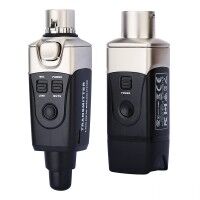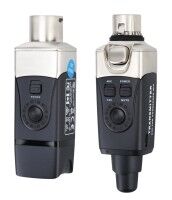



Get a 4 year extended warranty
Wouldn’t it be great, if we doubled the warranty for your product to 4 years? Sounds really good, doesn’t it? All you need to do for this warranty extension is to register your product with us. So, what are you waiting for?
More informationNothing works without cables
Microphones have been around for a long time. Early versions were used in the first modern telephones, invented in the second half of the 19th century. Whether it's these telephones or the rise of electric amplification for recording or live performances, there was always one essential element in transmitting sound converted into electrical signals: the cable! It does quite a remarkable job. The voltage generated by a microphone is extremely small. To ensure the most interference-free transmission of the signal, the choice was made to use the so-called balanced signal transmission. This is achieved through cables with two inner conductors and shielding, equipped with a 3-pin connector or socket (XLR) at either end. Usually, this connection leads into a microphone preamplifier (e.g., in a mixing console or audio interface), and from there into PA (loudspeakers) or recording systems (nowadays mostly DAW).
From necessity to art form
With the advent of ever larger live performances, especially in the 1960s and 70s, the microphone cable advanced from a necessary evil to a component of impressive show elements. Microphones were thrown or flung with the cable, only to be caught again, most of the time. In these music shows, but also in TV and film productions, cables were omnipresent. And usually, one or more people took care of the long lines, and thus the trouble-free process. But together with the other musicians, and their cables, it can get confusing on stage rather quickly.
Radio became the solution
As early as the 1950s, experiments began with the transmission of microphone signals by radio. The American company Shure and the German manufacturer Sennheiser were at the forefront in this regard. The transmitter was integrated into the microphone, where a battery supplied the necessary power. In the 1970s you could see the mostly silver microphones with the small antenna at the bottom more and more often. The receiver was then positioned at the FOH (front of house), where the connection to the mixing console was made by cable. Especially for the lead singers of big acts, this development was a liberation, in the proverbial sense. But also in TV productions, the increasingly reliable wireless technology started to be utilized with excellent results, gradually replacing the need for cables. The ability to transmit signals wirelessly created completely new possibilities. Headsets, which had transmitters in the form of bodypacks, made it possible to dance, perform and sing freely. Kate Bush, for example, proved this impressively. Initially very expensive, vocal microphones with wireless technology were more likely to be found in professional productions for a long time. The rapidly developing digital technology changed this, and nowadays you no longer have to buy a complete system, including the microphone capsule, but only get the necessary transmission technology, both small and inexpensive. With this set of transmitter and receiver, both not much larger than an XLR connector, any microphone can become a wireless microphone! But wireless systems are also very popular with creative people who create content for social media. A lavalier microphone is perfect for voice recording, and wireless is of course the first choice here as well!
Plug and Play for many applications
W-Music Distribution offers you the best price/performance ratio with XVive. Want to make your existing microphone wireless? Then the XVive U3 Microphone Wireless System (XVive U3 Microphone Wireless System for Dynamic Microphones | W-Music Distribution (warwick.de) is for you! It operates in the 2.4 GHz ISM band, and with its 6 switchable channels, it can be used reliably worldwide. With a very low latency, best frequency response and a built-in battery that lasts up to 5 hours, you get perfect wireless audio at a fair price! The transmitter and receiver are hardly larger than an XLR connector and offer real plug'n'play! The XVive U3D Dual Wireless System for PA/DJ Systems (XVive U3D Dual Wireless System for PA/DJ Systems | W-Music Distribution (warwick.de) is the problem solver if you don't want to mess with long cables when setting up active speakers or PAs. In this way, the loudspeakers can be placed according to the room and the event, and the proven wireless technology with the best audio quality replaces the cables. The XVive U5 Wireless Audio System with Lavalier Microphone (XVive U5 Wireless Audio System with Lavalier Microphone | W-Music Distribution (warwick.de) is exactly what you need as a content creator. The transmitter is worn as a bodypack while the receiver is attached to the camera's hot shoe. Even a lavalier microphone is included. Switchable channels in the 2.4 GHz ISM band, long battery life, best audio quality and ease of use at an attractive price. This, and much more, can be found at W-Music Distribution.









